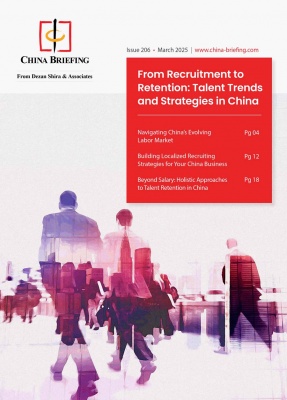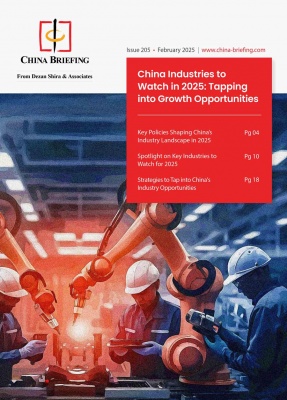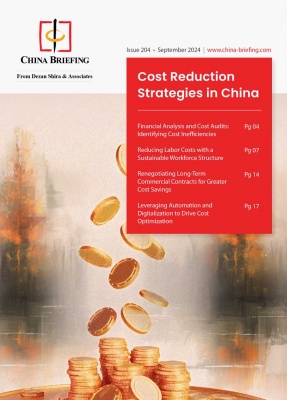China Robotics Industry: What Are the Opportunities for Foreign Stakeholders
- China has rapidly surpassed Germany and Japan in industrial robotics, leading the world with 470 robots per 10,000 employees in 2023. This figure eclipses Germany’s 429 and Japan’s 419, reflecting China’s aggressive automation push. The country accounted for 51 percent of global robot installations in 2023, with domestic manufacturers now holding 47 percent of the market, up from 28 percent a decade ago. China’s rise is supported by strategic policies and global investments, cementing its role as the world’s largest and fastest-growing robotics market.
- China’s proactive support for robotics development, backed by the “Robot+” Application Action Plan and the Foreign Investment Encouraged Catalogue, creates lucrative opportunities for foreign stakeholders in sectors like manufacturing, healthcare, education, and agriculture.
Over the years, China has risen to prominence in global robot adoption. According to the World Robotics 2024 report by the International Federation of Robotics (IFR), China recorded 470 robots per 10,000 employees in 2023, up from 402 in 2022. This figure surpasses Germany’s 429 and Japan’s 419, positioning China as third globally in robot density after South Korea and Singapore.
This growth underscores the success of national policies and the strong push toward automation. In the early 2000s, industrial robotics in China was in its infancy, with limited adoption and heavy reliance on foreign manufacturers. In 2023, domestic manufacturers accounted for over 30 percent of the market, a marked improvement from just 17 percent in 2015.
In 2023, China accounted for 51 percent of global industrial robot installations, with 276,288 units deployed, slightly below the record of 290,144 units set in 2022. These figures highlight China’s dominance as the world’s largest robotics market.
Since the 13th Five-Year Plan period, through continuous innovation and deeper application, China’s robotics industry has demonstrated a robust growth trajectory.
The industry’s scale has expanded rapidly. Technological advancements have accelerated, with significant breakthroughs in key technologies and components such as motion control, high-performance servo drives, and high-precision reducers. The functionality and performance of robots have significantly improved. Integration and application have expanded greatly.
The China Robotics Market segmentation, based on robot type includes traditional industrial robots, cobots, professional service robots, and others. The traditional industrial robots segment dominated the market, accounting for 53.2 percent in 2022. These robots are an integral part of the country’s push towards automation and smart manufacturing, which aligns with government initiatives like “Made in China 2025”.
The initiative, along with the “Robotics Industry Development Plan (2016-2020)” aimed to enhance innovation, improve the quality of domestic robotics, and expand their applications across industries, emphasizing smart manufacturing, healthcare, and service robotics.
By 2025, China set ambitious goals to become a global hub for robotics innovation, a center for high-end manufacturing, and a leader in integrated applications. These objectives have partially been achieved.
For example, the country aimed to achieve an annual revenue growth rate of over 20% in the robotics industry. Indeed, according to the Ministry of Industry and Information Technology (MIIT), for August 2024 China has remained the world’s largest market for industrial robots for an 11th consecutive year. In 2023, China’s industrial robot production had reached 430,000 sets, while the country’s newly added robot installations accounted for more than half of the global market over the past three years. As of July 2024, China boasted more than 190,000 effective robot-related patents, accounting for about two-thirds of the global total.
Moreover, China Robotics Market Size was valued at US$ 6.2 billion in 2022 and it grew to US$ 6.6 billion in 2023.
Government policies and initiatives
One of the most recent plan adopted by the government is “14th Five-Year Plan for Robot Industry Development”, included in the “14th Five-Year Plan for Economic and Social Development of the People’s Republic of China” and the 2035 Vision Outline. Aiming at accelerating the expansion of robot applications, it lead to the launch of the 《 “Robot+” Application Action Plan》, which environs that robots become a critical component of economic development, people’s daily lives, and social governance
The core principles of the plan are application-driven, with a focus on leadership and fundamental support. By harnessing the roles of various departments, local governments, and industries, the plan aims to prioritize product innovation and the promotion of real-world applications. Its objectives are to expand both the depth and breadth of robotic applications, foster the development of a robust robotics ecosystem, strengthen the competitiveness of domestic robot brands, and support the growth of China’s robotics industry toward greater self-reliance and global strength.
The plan focuses on several key areas to help grow China’s robotics industry. First, it emphasizes better coordination between different sectors like industry management, technology, finance, and policy, with the goal of supporting innovation. Local governments are encouraged to tackle major issues, ensuring that companies stay on top of safety and environmental concerns. Industry associations are also seen as crucial, helping to monitor progress and providing feedback on how things are going.
Financial support is another big priority. Research and development are boosted through national science and technology projects and key R&D programs, while companies can benefit from tax incentives to invest in R&D and support as they grow and even go public.
The plan also calls advocates for research into robotics ethics and legal frameworks to make sure the industry grows responsibly along with developing talents by training high-level professionals through collaborations between universities and businesses, as well as through vocational programs
On a regional level, multiple regions have recently introduced a range of policies to accelerate the growth of the robotics industry. For instance, on December 4, the Chongqing Municipal Economic and Information Technology Commission, together with seven other departments, unveiled the “Several Policy Measures to Support the Innovation and Development of Embodied Intelligent Robotics Industry in Chongqing.”
In addition, Hangzhou has launched the “Hangzhou Humanoid Robotics Industry Development Plan (2024–2029),” which highlights key initiatives across 15 areas aimed at fostering the high-quality development of the robotics sector. Other cities, including Nanjing and Sichuan Tianfu New Area, have also rolled out policies this year, harnessing local strengths and resources to propel the robotics industry to new heights.
The “Policy Measures” also emphasize the importance of boosting financial support for the robotics industry. They propose increasing investment from Chongqing’s industrial investment funds, industry capital, and social capital, alongside relevant districts and counties, to jointly establish an embodied intelligent robotics industry investment fund through market-driven approaches. Additionally, the policy encourages financial institutions to develop innovative financial services tailored to open-source projects and businesses within the embodied intelligent robotics sector.
These services include intellectual property pledge financing, equity financing, and interest subsidies for technological transformation and reinvestment projects within the robotics industry.
Opportunities for foreign stakeholders
As China continues to aggressively support the development of robotics technology, it is creating a favorable environment for foreign investment, which further fuels the growth of the robotics sector. Specifically, through the “Robot+” Application Action Plan, the government looks to build stronger international partnerships and create a mutual benefit environment.
The latest version of the “2022 FI Encouraged Catalogue” released by the National Development and Reform Commission (NDRC) and the Ministry of Commerce (MOFCOM) encourages foreign investment in specific industries, including robotics-related sectors.
Manufacturing industry
Manufacturing is the category that generates most income in the Chinese Robot Market, accounting for the 69.4 percent in 2022 of its revenue.
Robotics applications are being promoted on a large scale in industries such as automotive, electronics, machinery, light industry, textiles, building materials, and pharmaceuticals. Additionally, specialized fields like bathroom products, ceramics, photovoltaics, smelting, casting, sheet metal, hardware, and furniture are also seeing increased adoption of robotics. Key processes, such as glazing, embryo repair, polishing, grinding, welding, spraying, handling, and stacking, are being optimized with robotic solutions.
To address specific industry needs, specialized and customized solutions are being created, along with software and hardware products that integrate deeply with robotic control systems. This includes the development of model libraries, process software packages, and integrated application systems.
This strategic emphasis on robotics within manufacturing presents a lucrative opportunity for foreign stakeholders to invest in and collaborate with the country’s thriving robotics sector.
Establishing and improving innovation systems
China is leveraging its key robotics laboratories, engineering research centers, and innovation hubs to strengthen research on frontier technologies. The goal is to accelerate the transfer and transformation of innovative achievements, thus fostering an effective industrial technology innovation chain. Leading enterprises are encouraged to collaborate on R&D efforts, driving standardization and modularization in robotics software and hardware. Foreign investors are particularly encouraged to invest in the R&D and application of 5G, IoT, and blockchain technologies, which are critical for advancing robotics innovation.
Education and robotics integration
The 2025 plan sees robotics applications expanding into the education sector, particularly in integrating 5G, AI, intelligent voice, machine vision, big data, and digital twins with robotics. This initiative presents a new platform for foreign investments, especially in non-academic vocational training institutions. The promotion of robotics in teaching, research, skills training, and campus safety aligns well with the opportunities presented in the 2022 catalogue, which encourages foreign investment in the education sector.
Healthcare and social welfare
The “Robot+” application is also gaining traction in healthcare and elderly services, areas identified as promising for foreign investors in the 2022 catalogue. These fields include home, community, and institutional elderly care, as well as the construction and operation of related facilities. Robotics is being utilized to accelerate advancements in AI-assisted diagnosis, 5G remote surgery, brain-machine interface-assisted rehabilitation, and hospital rehabilitation services. The development of standards and norms for robot applications in elderly care is also a key focus, which enhances the potential for smart elderly services and disability assistance.
Agricultural robotics applications
The agricultural sector is another key area for robotics integration, with robots being developed for farming tasks such as soil preparation, irrigation, pest control, and harvesting. Additionally, robots for animal husbandry and aquaculture are increasingly in demand, covering activities such as feeding, cleaning, disease prevention, and environmental control. These developments are supported by the production of specialized fertilizers and pesticides, as outlined in the 2022 catalogue, as well as the creation of intelligent mobile platforms for precision agriculture. This opens up further opportunities for foreign investors in the agricultural, forestry, animal husbandry, and fishery industries, particularly in large-scale fields, greenhouses, and livestock management.
About Us
China Briefing is one of five regional Asia Briefing publications, supported by Dezan Shira & Associates. For a complimentary subscription to China Briefing’s content products, please click here.
Dezan Shira & Associates assists foreign investors into China and has done so since 1992 through offices in Beijing, Tianjin, Dalian, Qingdao, Shanghai, Hangzhou, Ningbo, Suzhou, Guangzhou, Haikou, Zhongshan, Shenzhen, and Hong Kong. We also have offices in Vietnam, Indonesia, Singapore, United States, Germany, Italy, India, and Dubai (UAE) and partner firms assisting foreign investors in The Philippines, Malaysia, Thailand, Bangladesh, and Australia. For assistance in China, please contact the firm at china@dezshira.com or visit our website at www.dezshira.com.
- Previous Article Beijing New Market Access Updates: Opportunities for Foreign Businesses and Investors
- Next Article China-UK Economic Ties: Trade, Investment, and 2025 Prospects
























